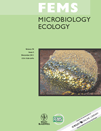Communities of purple sulfur bacteria in a Baltic Sea coastal lagoon analyzed by puf LM gene libraries and the impact of temperature and NaCl concentration in experimental enrichment cultures
Abstract
Shallow coastal waters, where phototrophic purple sulfur bacteria (PSB) regularly form massive blooms, are subjected to massive diurnal and event-driven changes of physicochemical conditions including temperature and salinity. To analyze the ability of PSB to cope with these environmental factors and to compete in complex communities we have studied changes of the environmental community of PSB of a Baltic Sea lagoon under experimental enrichment conditions with controlled variation of temperature and NaCl concentration. For the first time, changes within a community of PSB were specifically analyzed using the photosynthetic reaction center genes pufL and M by RFLP and cloning experiments. The most abundant PSB phylotypes in the habitat were found along the NaCl gradient from freshwater conditions up to 7.5% NaCl. They were accompanied by smaller numbers of purple nonsulfur bacteria and aerobic anoxygenic phototrophic bacteria. Major components of the PSB community of the brackish lagoon were affiliated to PSB genera and species known as marine, halophilic or salt-tolerant, including species of M arichromatium, H alochromatium, T hiorhodococcus, A llochromatium, T hiocapsa, T hiorhodovibrio, and T hiohalocapsa. A dramatic shift occurred at elevated temperatures of 41 and 44°C when M arichromatium gracile became most prominent which was not detected at lower temperatures.




